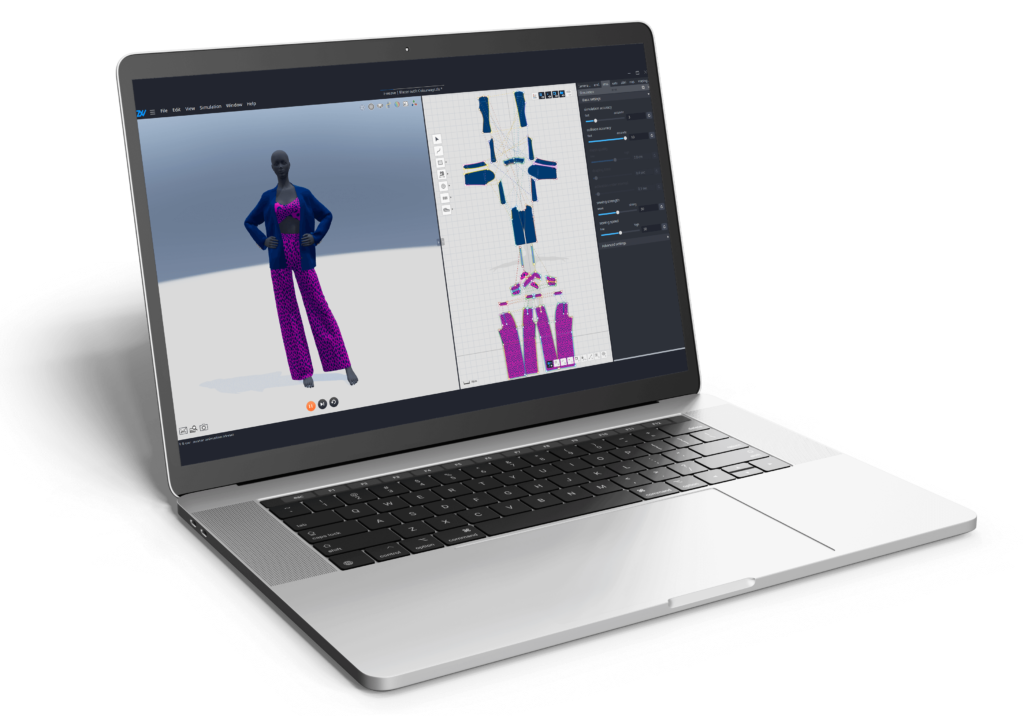Summary
- Technology and pattern making have always gone hand in hand to enhance the quality of apparel manufacturing.
- Digital solutions continue to evolve to simplify this work, and 3D pattern making is here to stay.
- Discover the best that this cutting-edge technology has to offer. Try Audaces360 for free!
Developing an agile process that saves time and maintains quality work. This is undoubtedly the greatest desire of anyone working in the fashion industry.
Some steps are more difficult to develop than others. But pattern making has been one of the areas that has evolved the most in recent times.
We want to show you the benefits of adopting 3D pattern making and transforming your way of working. That’s why we have prepared this complete guide in the following lines.
Enjoy your reading!
Sumário
Why is it so important for a pattern maker to know how to create a 3D pattern?
Mastering 3D pattern design empowers you to visualize how fabrics will drape and fit on the body. You can test your patterns before cutting any fabric.
The ability to explore digital solutions makes your work more precise and efficient. This is because it eliminates the need for manual development.
You can create your patterns in a digital environment in 2D, using vector lines. Then, you can test these patterns on a 3D mannequin.
This way, it is possible to ensure the garment will align with the fashion designer’s vision. In addition, it will achieve the desired fit, enhancing customer satisfaction.
Learn more: Learn what 3D modeling is and its benefits for clothing design and production
What are the steps involved in the 3D pattern making process?
The 3D pattern process typically involves the same key steps, from pattern creation to the final view. This is usually the sequence:
Pattern creation
This stage marks the starting point – creating the base pattern for your garment. In the past, it was common practice to create these patterns manually using specialized paper and rulers.
However, paper patterns have become obsolete due to their time-consuming nature and inherent difficulty in achieving precision.
Nowadays, you can use two main approaches:
- Digital creation: utilize 2D software to create the initial pattern pieces using vector lines. This method offers precise control and easy editing.
- Digitized physical patterns: convert existing physical patterns into digital files using specific solutions. This eliminates the need for redrawing and ensures accuracy.
Digital files offer numerous advantages, particularly in terms of storage. They don’t take up physical space and ensure the integrity of your patterns.
Furthermore, it’s safer to keep them saved in a digital environment. This way, you can access them whenever you want.
Version control gets a major upgrade too. Digital patterns let you track and update changes, ensuring you always work with the latest and most accurate version.
Learn more: 3 basic principles to create your clothing pattern design
Size grading
Grading is an essential step that involves adjusting the base pattern to create garments in different sizes. Traditionally, this process required manually scaling each pattern piece by a specified percentage to achieve other sizes.
This method was labor-intensive and prone to human error, as only precise calculations maintain the correct proportions.
However, with advancements in technology, digital pattern design transformed the grading process. Instead of manual scaling, new solutions automate grading by allowing designers to input size parameters.
The software then generates graded patterns for each size efficiently and accurately. This automation not only speeds up the production process, but also minimizes errors that can occur during manual grading.
Learn more: Discover the benefits of a pattern grading chart for your clothing production
Adjustments and detailing

At this point, the focus is refining and perfecting the digital pattern for the ideal fit and style. By using digital solutions, you can easily adjust your patterns. For example, adding details like seams, darts, and pleats.
The software also helps ensure the symmetry and alignment of pattern pieces. Moreover, you can virtually drape the fabric on a 3D model to see how it moves and behaves.
This goes beyond a static simulation. You can observe the fabric’s interaction with the body in motion. It helps identify potential drape issues and restriction of movement early on.
3D preview
Once the pattern is ready, you can use 3D software to create a virtual preview of your garment. It means virtually sewing the patterns together and seeing how they look on a 3D mannequin.
You can pose the mannequin in different ways to see how the garment looks. This 3D pattern preview lets you check the fit, how the fabric falls, and how the whole outfit looks from every angle.
It’s a key step to test measurements and fittings and catch any problems with the pattern before making physical samples.
Learn more: 5 benefits of 3D modeling software in your apparel company
Benefits of starting to test your patterns in 3D
By now, you should have realized some of the benefits of using 3D pattern. It’s a game-changer for fashion design, allowing for more creativity and fewer errors along the way.
To further explore the reasons to adopt this technology, let’s delve into how it will impact the pattern maker’s work:
Accuracy of measurements
Accurate measurements are crucial for making clothes. Small errors can cause big fit problems later. 3D pattern making solves this with precise measurements, ensuring clothes fit perfectly.
Unlike traditional manual methods, which can lead to errors, 3D pattern can reproduce the exact body dimensions.
You can digitally drape the pattern on a model, gaining a much clearer idea of how the garment will fit in real life. This significantly reduces the need for multiple trial-and-error physical prototypes to achieve the perfect fit.
Learn more: Understand the importance of a pattern maker for fashion manufacturing
Time optimization
It’s all about working smarter, not harder. Traditionally, creating physical samples and adjusting them is a time-consuming and iterative process.
Creating each revision involves making a new prototype. Besides, you must wait for the sewing process, and potentially start over if the changes don’t meet your vision.
With 3D pattern, you can conduct virtual prototyping instead. It leads to up to a 70% reduction in the development process time!
Digital adjustments instantly reflect on the 3D model, significantly reducing revision time and collection approval.
This allows you to perfect your designs faster and more efficiently before they go into production.
Ease of grading

One of the most significant benefits of integrating 2D and 3D pattern making lies in the area of size grading.
The precision of 2D patterns serves as a solid foundation for size grading. You can define the base size and size increments within the software.
Integrated solutions allow for seamless transfer of the graded 2D patterns into the 3D environment. It eliminates the need for manual scaling and redrawing of patterns for each size in 3D.
Then, the 3D patterns have the ability to generate virtual models in different sizes. This allows you to visualize how the garment will drape and fit across various body sizes, ensuring consistency.
Cost reduction
The 3D pattern is a smart way to reduce costs. Traditional methods involve expenses for materials used in physical prototypes and potential waste from discarded samples.
Testing patterns in a 3D environment ensures you only use the material when you’re certain the garment is perfect.
In addition, it’s possible to lower labor costs as well. This is particularly important if you outsource the pattern making process.
With 3D pattern, the creation and refinement processes are much faster, which consequently leads to lower labor costs.
Learn more: What are invisible costs and how to eliminate them in fashion manufacturing
More sustainable process
Building on the cost savings, the 3D pattern design also promotes a more sustainable process. The fashion industry produces a significant amount of fabric waste from discarded prototypes and samples.
Technology offers a solution by using virtual prototyping, allowing you to cut down on fabric waste significantly.
This approach helps to support a more environmentally conscious fashion industry, making a positive impact on our planet’s resources.
Learn more: How to master sustainable creation and production in the eco fashion era
Experience the best of 3D pattern with Audaces solutions

For over 30 years, Audaces has been a global leader in fashion technology innovation. Our user-friendly solutions empower fashion professionals to accelerate creation, development, and production.
But our expertise extends beyond fashion – we serve the upholstery, footwear, furniture, and other flexible material industries with intelligent solutions.
Audaces Pattern
For pattern makers looking for excellence, Audaces Pattern is an essential solution. It ensures the pattern of clothing creation reaches a new level of efficiency and precision.
With its dynamic and versatile approach, it is possible to develop high-quality patterns, regardless of complexity. Refine every detail to perfection, ensuring that your creative vision translates into patterns.
This important ally will help you in your journey toward success in the fashion industry. It will give you the confidence to stand out in the market!
Audaces 3D
Audaces 3D is the essential solution for pattern makers to bring creations to life in a three-dimensional mannequin.
With a range of tools and possibilities, this software transforms the creative and development processes. Paper patterns of clothing days will soon be in the past!
Test your digital pattern before creating a physical sample. This helps save time and resources by identifying issues early in the process.
Additionally, it enables you to shape your ideas directly in a digital environment, gaining agility and quality in deliveries.
Keep exploring our resources, download our free e-book today!
FAQ
Mastering 3D pattern design empowers you to visualize how fabrics will drape and fit on the body. You can test your patterns before cutting any fabric.
Pattern creation, size grading, adjustments and detailing, and 3D preview.
Accuracy of measurements, time optimization, ease of grading, cost reduction, and more sustainable process.










